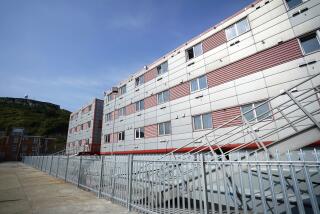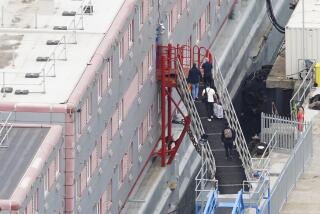Swedish Ferry a Way Station for Refugees : Immigration: Asylum seekers await outcome of requests to go ashore. More than half are denied permission.
- Share via
STOCKHOLM, Sweden — A converted tourist ferry named Friendship is where life in Sweden starts, or is denied, for hundreds of political refugees.
It is anchored off an industrial area and houses 250 asylum seekers awaiting decisions on whether they will be sent home or to refugee camps ashore.
Sweden turned away 60% of asylum seekers last year, double the percentage in 1989.
The Friendship has been declared unsuitable for children and will close this month as part of the Immigration Board’s plan to eliminate three-fourths of the 140 refugee centers in two years.
Many inmates sleep in four-berth cabins without windows. They complain of bland food and defective heating.
“This winter, when there were many Somalis staying, people used to set off the fire alarm every night as a protest,” said Margareta Tham, an administrator.
Asylum seekers are not allowed to work, but many take jobs for cash as manual laborers. They are fed and given a daily allowance equivalent to about $5 to spend ashore. About 80% of those on the Friendship are men.
Officials try to make sure that people in a cabin have a common language. Conflicts are rare, and Eddie Johansson, another administrator, said they do not progress beyond arguments.
Many of those aboard are Kurds, Iranians, Iraqis, Turks, Somalis, Ethiopians or Yugoslavs. Recent arrivals are from the Soviet Union and its Baltic republics.
One recent day, refugees on the ship stood in line to see a counselor. Others sat in the lounge, reading, talking or watching television.
Once a week, the refugees clear away boxes of supplies and equipment in the cargo hold and have a soccer game.
Tham said she felt her main task was talking and comforting, but she often feels at a loss.
“Talking doesn’t always help,” she said. “We’ve got Kurds here who know their home area (in Iraq) has been bombed, and that’s a worry you can’t help with.”
Idleness, painful memories and doubts about the future cause depression, insomnia and loss of appetite. About 10% of the refugees had suffered physical injury, including torture, in their homelands.
A 27-year-old nurse from Uganda said soldiers killed her father and brothers after her husband, a guerrilla, went into hiding. She said she was arrested for taking medicine to rebels, and soldiers plucked out her braids by hand.
“All centers should have a psychiatrist,” Tham said. “Now we send people to a hospital, which often has no experience of refugees and ends up calling us, asking what to do.”
Exiles paint in a small workshop unique to the Friendship. Some paintings depict ravaged people, others colorful landscapes.
“As you can see, there are not only sad pictures here but also happy ones,” said Ulla Hvid, a therapist.
More to Read
Sign up for Essential California
The most important California stories and recommendations in your inbox every morning.
You may occasionally receive promotional content from the Los Angeles Times.













